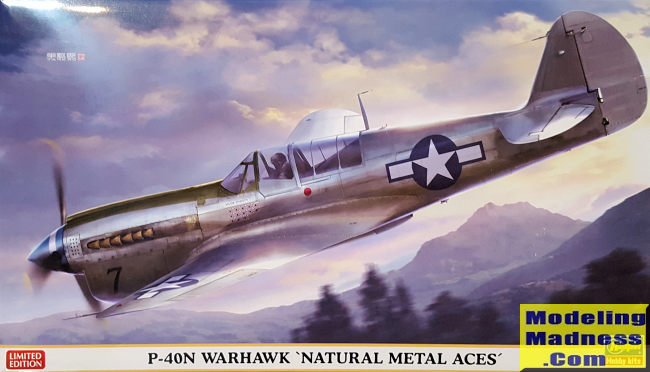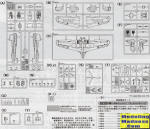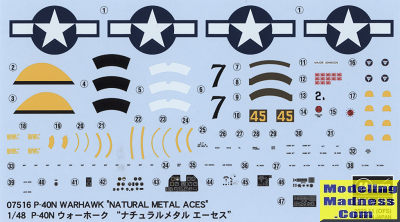
| KIT #: | 07516 |
| PRICE: | 3040 yen plus shipping from Japan |
| DECALS: | Two options |
| REVIEWER: | Scott Van Aken |
| NOTES: |
2022 Limited Edition |

| HISTORY |
The P-40N (manufactured 1943–44), was the final production model. The P-40N featured a stretched rear fuselage to counter the torque of the more powerful, late-war Allison engine, and the rear deck of the cockpit behind the pilot was cut down at a moderate slant to improve rearward visibility. A great deal of work was also done to try and eliminate excess weight to improve the Warhawk's climb rate. Early N production blocks dropped a .50 in (12.7 mm) gun from each wing, bringing the total back to four; later production blocks reintroduced it after complaints from units in the field.
Supplied to Commonwealth air forces as the Kittyhawk Mk IV. A total of 553 P-40Ns were acquired by the Royal Australian Air Force, making it the variant most commonly used by the RAAF. Subvariants of the P-40N ranged widely in specialization from stripped down four-gun "hot rods" that could reach the highest top speeds of any production variant of the P-40 (up to 380 mph), to overweight types with all the extras intended for fighter-bombing or even training missions. The 15,000th P-40 was an N model decorated with the markings of 28 nations that had employed any of Curtiss-Wright's various aircraft products, not just P-40s. "These spectacular markings gave rise to the erroneous belief that the P-40 series had been used by all 28 countries." Since the P-40N was by 1944 used mainly as a ground attack aircraft in Europe, it was nicknamed B-40 by pilots. Survivors redesignated as ZF-40N in June 1948.
| THE KIT |
 came
out in 2005. I built one in Feb of that year so perhaps they were really
released in 2004. Regardless, Hasegawa has boxed and reboxed pretty much all
the variants of the later P-40s except for the F and L. This is undoubtedly
due to the different engine of both of those.
came
out in 2005. I built one in Feb of that year so perhaps they were really
released in 2004. Regardless, Hasegawa has boxed and reboxed pretty much all
the variants of the later P-40s except for the F and L. This is undoubtedly
due to the different engine of both of those.
The cockpit is quite nice for right from the box. The fuselage is split to allow for different length tail sections. There is an insert for behind the pilot to deal with the different rear window shapes. Exhaust are paired meaning there are three pieces per side. There are also inserts for the wing guns and ejector chutes. There are options for either a drop tank or single bomb under the fuselage.
A couple of things one will have to do. The kit provides lights under the cockpit and in the forward part of the 'knuckles' that will have to be filled in and sanded smooth. There are also optional clear wingtip and fin lights. To use these the molded in ones will have to be removed. Then there are the wheels. The P-40N was a 'lightweight' version and so it had smaller, spoked, wheels. The kit does not supply those so you will need to go for something from the aftermarket crowd to replicate that. Having said that, often times a unit would simply put on the larger wheels, especially if they didn't have the proper replacements. A look at period photos shows P-40Ns with and without the lighter wheels so the choice is yours.
 You are
provided markings for two aircraft from the 49th FG from 1944. Both are
unpainted metal with an OD nose antiglare panel. The box art plane with the blue
spinner is from the 7th FS flown by Gerald Johnson and is the 'aces' plane. The
other option has a white tail section with a yellow spinner and fin tip. It was
with the 8th FS and flown by Marion Felts. The decal sheet is very nicely
printed and should work just fine. Note that the fin tip and prop bands are
provided as decals along with those for the instrument panel.
You are
provided markings for two aircraft from the 49th FG from 1944. Both are
unpainted metal with an OD nose antiglare panel. The box art plane with the blue
spinner is from the 7th FS flown by Gerald Johnson and is the 'aces' plane. The
other option has a white tail section with a yellow spinner and fin tip. It was
with the 8th FS and flown by Marion Felts. The decal sheet is very nicely
printed and should work just fine. Note that the fin tip and prop bands are
provided as decals along with those for the instrument panel.
| CONCLUSIONS |
February 2023
Copyright ModelingMadness.com. All rights reserved. No reproduction in part or in whole without express permission from the editor.
If you would like your product reviewed fairly and fairly quickly, please contact the editor or see other details in the Note to Contributors.